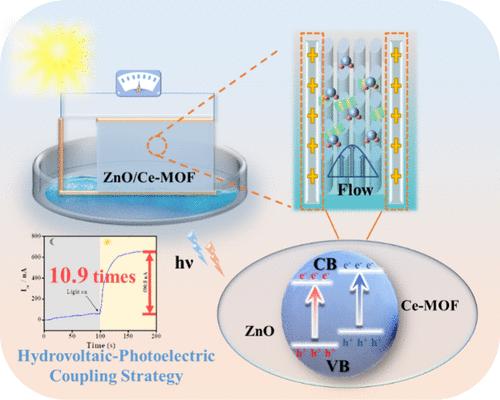当前位置:
X-MOL 学术
›
Anal. Chem.
›
论文详情
Our official English website, www.x-mol.net, welcomes your
feedback! (Note: you will need to create a separate account there.)
Hydrovoltaic–Photoelectric Coupling Strategy Triggered a Robust Output Signal for High-Performance Self-Powered Electrochemical Sensing
Analytical Chemistry ( IF 6.7 ) Pub Date : 2024-11-13 , DOI: 10.1021/acs.analchem.4c03477 Yuqing Bian, Ding Jiang, Hanling Ding, Xiaojiao Du, Xueling Shan, Wenchang Wang, Hiroshi Shiigi, Zhidong Chen
Analytical Chemistry ( IF 6.7 ) Pub Date : 2024-11-13 , DOI: 10.1021/acs.analchem.4c03477 Yuqing Bian, Ding Jiang, Hanling Ding, Xiaojiao Du, Xueling Shan, Wenchang Wang, Hiroshi Shiigi, Zhidong Chen

|
Hydrovoltaic self-powered electrochemical sensors hold significant potential for constructing wearable, portable, and real-time detection devices, but the low output signal due to the slow phase transition rate of water molecules and the intricate nature of integration limits their applications. In this work, a hydrovoltaic–photovoltaic coupling effect-enhanced self-powered electrochemical sensor was prepared by combining zinc oxide (ZnO) nanowire arrays with cerium-organometallic framework (Ce-MOF) materials, which greatly improved the electrical output of self-powered electrochemical systems and provided a new detection strategy for an efficient self-powered electrochemical sensing system. The heterojunction constructed by ZnO arrays and Ce-MOF could generate a built-in electric field under the action of light irradiation and promote the separation of the photocarriers. Moreover, the number of charged particles in the film further boosted the water evaporation effect. Notably, the optimal ZnO/Ce-MOF-based self-powered electrochemical device by hydrovoltaic–photoelectric coupling strategy displayed an outstanding output signal, which was 11-fold that of a pure hydrovoltaic-based device. As a proof of concept, the self-powered electrochemical sensing platform was explored for sensitive detection of lincomycin via electrostatic adsorption for the binding of an aptamer. The self-powered sensor showed superior performances, including a wide linear range from 1 fM to 1 nM with a detection limit of 0.2 fM, good stability, and satisfactory recoveries for the determination of lincomycin in real samples, holding great promise in environmental monitoring and food analysis. This study provides a promising avenue to boost the energy conversion efficiency with a high output signal for constructing sensitive self-powered biosensors.
中文翻译:

Hydrovoltaic-Photoelectric 耦合策略触发了用于高性能自供电电化学传感的鲁棒输出信号
水力光伏自供电电化学传感器在构建可穿戴、便携式和实时检测设备方面具有巨大潜力,但由于水分子的缓慢相变速率和集成的复杂性,低输出信号限制了其应用。本工作通过将氧化锌 (ZnO) 纳米线阵列与铈有机金属框架 (Ce-MOF) 材料相结合,制备了一种水光伏耦合效应增强的自供电电化学传感器,大大提高了自供电电化学系统的电输出,为高效的自供电电化学传感系统提供了新的检测策略。由 ZnO 阵列和 Ce-MOF 构建的异质结可以在光照射的作用下产生内置电场,并促进光载流子的分离。此外,薄膜中带电粒子的数量进一步增强了水分蒸发效应。值得注意的是,采用水压-光电耦合策略的基于 ZnO/Ce-MOF 的自供电电化学器件表现出出色的输出信号,是纯水压器件的 11 倍。作为概念验证,探索了自供电电化学传感平台,通过静电吸附对适配体的结合灵敏检测林可霉素。该自供电传感器表现出优异的性能,包括 1 fM 至 1 nM 的宽线性范围,检出限为 0.2 fM,稳定性好,在测定实际样品中林可霉素的回收率令人满意,在环境监测和食品分析中具有很大的前景。 本研究为构建灵敏的自供电生物传感器提供了一条有前途的途径,可以提高高输出信号的能量转换效率。
更新日期:2024-11-13
中文翻译:

Hydrovoltaic-Photoelectric 耦合策略触发了用于高性能自供电电化学传感的鲁棒输出信号
水力光伏自供电电化学传感器在构建可穿戴、便携式和实时检测设备方面具有巨大潜力,但由于水分子的缓慢相变速率和集成的复杂性,低输出信号限制了其应用。本工作通过将氧化锌 (ZnO) 纳米线阵列与铈有机金属框架 (Ce-MOF) 材料相结合,制备了一种水光伏耦合效应增强的自供电电化学传感器,大大提高了自供电电化学系统的电输出,为高效的自供电电化学传感系统提供了新的检测策略。由 ZnO 阵列和 Ce-MOF 构建的异质结可以在光照射的作用下产生内置电场,并促进光载流子的分离。此外,薄膜中带电粒子的数量进一步增强了水分蒸发效应。值得注意的是,采用水压-光电耦合策略的基于 ZnO/Ce-MOF 的自供电电化学器件表现出出色的输出信号,是纯水压器件的 11 倍。作为概念验证,探索了自供电电化学传感平台,通过静电吸附对适配体的结合灵敏检测林可霉素。该自供电传感器表现出优异的性能,包括 1 fM 至 1 nM 的宽线性范围,检出限为 0.2 fM,稳定性好,在测定实际样品中林可霉素的回收率令人满意,在环境监测和食品分析中具有很大的前景。 本研究为构建灵敏的自供电生物传感器提供了一条有前途的途径,可以提高高输出信号的能量转换效率。


















































 京公网安备 11010802027423号
京公网安备 11010802027423号